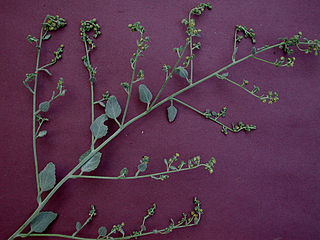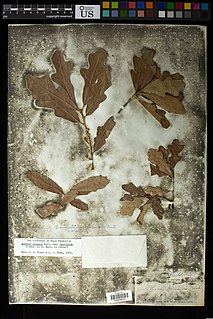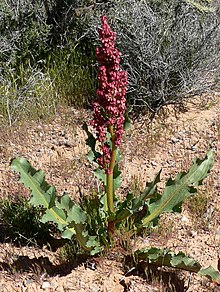
Sorrel, also called common sorrel or garden sorrel, is a perennial herbaceous plant in the family Polygonaceae. Other names for sorrel include spinach dock and narrow-leaved dock.

The genus Androstephium is a group of North American plants in the cluster lily subfamily within the asparagus family. It contains two species native to the southwestern and south-central United States.
- Androstephium breviflorumS.Watson - pink funnel lily - deserts of Arizona, Utah, southeastern California, southern Nevada, northwestern New Mexico, western Colorado, southern Wyoming
- Androstephium coeruleum(Scheele) Greene - blue funnel lily - grasslands of Texas, Oklahoma, Kansas

John Torrey was an American botanist, chemist, and physician. Throughout much of his career, he was a teacher of chemistry, often at multiple universities, while he also pursued botanical work, focusing on the flora of North America. His most renowned works include studies of the New York flora, the Mexican Boundary, the Pacific railroad surveys, and the uncompleted Flora of North America.

The docks and sorrels, genus Rumex, are a genus of about 200 species of annual, biennial, and perennial herbs in the buckwheat family, Polygonaceae. Members of this genus are very common perennial herbs with a native almost worldwide distribution, and introduced species growing in the few places where the genus is not native.

Rumex crispus, the curly dock, curled dock or yellow dock, is a perennial flowering plant in the family Polygonaceae, native to Europe and Western Asia.

Nathaniel Lord Britton was an American botanist and taxonomist who co-founded the New York Botanical Garden in the Bronx, New York.

Rumex acetosella, commonly known as red sorrel, sheep's sorrel, field sorrel and sour weed, is a species of flowering plant in the buckwheat family Polygonaceae. Native to Eurasia and the British Isles, the plant and its subspecies are common perennial weeds. It has green arrowhead-shaped leaves and red-tinted deeply ridged stems, and it sprouts from an aggressive and spreading rhizome. The flowers emerge from a tall, upright stem. Female flowers are maroon in color.

Agave lechuguilla is an Agave species found only in the Chihuahuan Desert, where it is an indicator species. It typically grows on calcareous soils. The plant flowers once in its life and then dies. The flowers are a source of nutrients for insects, bats, and some birds.

Prunus fasciculata, also known as wild almond, desert almond, or desert peach is a spiny and woody shrub producing wild almonds, native to the deserts of Arizona, California, Baja California, Nevada and Utah.

Dicoria canescens is a North American flowering plant in the daisy family known by several common names including desert twinbugs and bugseed. This is a desert plant of the southwestern United States and northwestern Mexico, found in Sonora, Baja California, southern California, Nevada, Arizona, Utah, southwestern Colorado, and northwestern New Mexico.

Quercus sinuatavar. breviloba, commonly called Bigelow oak or Bigelow's oak, is a variety of Quercus sinuata, a species of oak tree that grows in parts of the southern United States and northeastern Mexico. Common names for this taxon are shallow-lobed oak, white shin oak, scaly-bark oak, limestone Durand oak, and shortlobe oak. The less specific common name bastard oak may refer to either of the two varieties of Quercus sinuata, var. sinuata and var. breviloba. Other common names include scrub oak or shin oak, but these names may refer to a number of other low growing, clump forming oak species, subspecies or varieties. For clear differentiation in common reference, American Forests uses Durand Oak to mean Quercus sinuata var. sinuata and Bigelow oak to mean Quercus sinuata var. breviloba, a shrubby variety of Quercus sinuata distinguished in part by its habit of forming clonal colonies in parts of its range.

Rumex brownii, the hooked dock, Browne's dock or swamp dock, is a leafy perennial herb native to Australia, and is widespread and grows in disturbed sites. It is an introduced weed in the Pacific Islands, England, Japan, and New Zealand.

Enemion biternatum, commonly known as the false rue-anemone, is a spring ephemeral native to moist deciduous woodland in the eastern United States and extreme southern Ontario.

Rumex venosus is a species of flowering plant in the knotweed family known by the common names veiny dock, winged dock, sand dock, and wild-begonia. While not of any particular agricultural use, its cousins rhubarb and buckwheat are. It is native to central and western North America, from southern parts of the Canadian prairies, through to Mexico.

Lixus concavus, commonly called the rhubarb curculio, is a species of weevil. Rhubarb is a host, together with dock, sunflower, and thistle.

Rumex alpinus, common name monk's-rhubarb, Munk's rhubarb or Alpine dock, is a leafy perennial herb in the family Polygonaceae. It is native to upland areas of Europe and Western Asia.

Ambrosia salsola, commonly called cheesebush, winged ragweed, burrobush, white burrobrush, and desert pearl, is a species of perennial shrub in the sunflower family native to deserts of the southwestern United States and northwestern Mexico.

Rumex sanguineus, commonly known as wood dock, bloody dock or red-veined dock, is a perennial flowering plant species in the family Polygonaceae. Rumex sanguineus is a dicot and can be observed in Europe with at least two varieties.

Rumex fueginus, known as American dock, golden dock, and Tierra del Fuego dock, is a flowering plant in the family Polygonaceae. Rumex fueginus was first formally named by Rodolfo Armando Phillipi. Rumex fueginus is native from Canada in northern North America to Tierra del Fuego at the southern tip of South America. It has previously been considered a subspecies or variety of Rumex maritimus, a Eurasian species.
Rumex spiralis is a flowering plant commonly known as winged dock in the family Polygonaceae. This is a perennial herbaceous plant that is predominately native to southern Texas. This plant grows between 0–200 m in altitude.




















